Affiliated Homepage Shortcut Button
Kids KOGAS
KOGAS
Current page :
Unloading Jetty
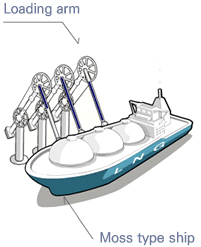
Korea imports LNG from 16 contries (as of 2016) including Qatar, Australia, Oman, and Malaysia. It takes about 15 days for an LNG carrier to make a round trip to Southeast Asia, and about a month to the Middel East.
On arrival in Korea, the, LNG carrier is delivered to the jetty in a LNG terminal by 4 Tug Boats,
and after arriving at the jetty, it is fixed at the pier with a mooring rope to minimize the movement of the ship during unloading.
When the LNG carrier is fixed in place, three LNG unloading arms and one NG arm are connected, and the LNG is transferred through the unloading piping to the onshore storage tanks using the transfer pumps on the LNG carrier side.
The reason for connecting the NG arm is to compensate for reduced pressures in the carrier tanks caused by level decrease of LNG tanks on the carrier side.
This can cause damage to the tanks, -Boil-off gas (BOG) generated at the production base is supplied to the ship to compensate the pressures.A lot of BOG is generated in the early stage of unloading because LNG evaporates while LNG is being unloaded through the unloading piping, where the temperature is partially elevated. The amount of LNG loaded on one LNG carrier is usually 125,000 m3 (approx. 57,000 tons) or 135,000 m3 (approx. 62,000 tons).
When LNG unloading starts, a portion of LNG is collected from the unloading piping to analyze its composition, heating value, and weight, and when the unloading is completed, the LNG carrier is separated from the unloading facilities. It takes approx. 12 hours to unload LNG to the LNG storage tanks in the terminals, but the ship docks for approx. 21 hours because of the unloading preparation process, loading of food and repair materials needed on the ship, and changing crew.
Storage Tank
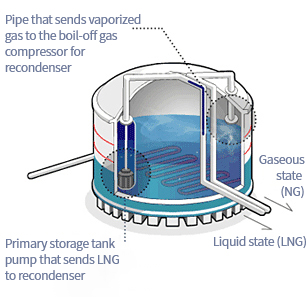
KOGAS operates LNG terminals in five locations: Pyeongtaek, Incheon, Tongyeong, Samcheok, and Jeju.
LNG storage tanks serve as a buffer to resolve the imbalance between supply and demand by storing LNG in seasons when city gas demand is low, and supplying LNG in winter when demand exceeds supply.There are 4 capacities of storage tanks: 100,000 kL (45,000 tons), 140,000 kL (63,000 tons), 200,000 kL (89,000 tons), and 270,000 kL (121,000 tons).
The storage tanks are composed of an outer wall of special concrete, cold insulations to protect the LNG from external heat, an inner wall made of special material that can withstand extremely low temperatures, and attached devices.
Auxiliary facilities include the primary LNG pumps for discharging LNG from the tank, various instruments to monitor the tank’s operation status, and safety facilities to monitor gas leakage and fire.
Boil-off Gas Compressor
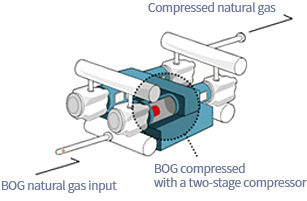
Since LNG is a cryogenic liquid with a boiling temperature of -162°C, it evaporates by heat transferred from the outside of the storage tank, and this evaporated gas is called boil-off gas (BOG). A BOG compressor either sends BOG to a recondenser, or re-liquefies BOG by compressing it to use it as fuel gas in the terminal
Although the main component of LNG is methane (CH4), it also contains some ethane (C2H6) and propane (C3H8), and the composition differs slightly depending on the production area.In case re-condensing is impossible, a high-pressure gas compressor is also installed so that the compressed boil-off gas can be compressed at a higher pressure to be sent directly to the high-pressure delivery piping.
Recondenser
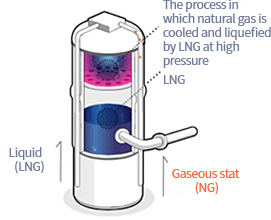
This facility recondenses the boil-off gas (BOG) compressed by the BOG compressor with LNG.
The LNG supplied by the primary pump in the LNG storage tank and the BOG pressurized by the BOG compressor are respectively injected into the re-liquefier and mixed.The low temperature LNG (-160° to -150°C) and the relatively high temperature BOG (5-35°C) are mixed, the BOG is converted into LNG (-150°C to -130°C) in the recondenser unit through heat exchange, and this is then transferred to the secondary pump.
The LNG can remain liquid even when the temperature rises because the boiling point increases as the pressure increases. In other words, LNG boils at a higher temperature rather than at -162°C under higher pressure.
Secondary Pump
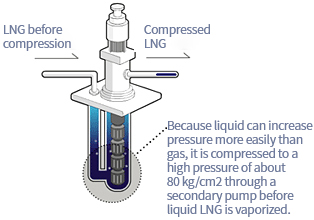
A high pressure is required to supply natural gas to consumers through the nationwide supply pipeline network. Since liquid can increase the pressure more easily than gas, it is compressed to a high pressure of approx. 80 kg/cm2 with a secondary pump before the LNG is vaporized. In addition, when the pressure of LNG is high, it has the advantage of needing less heat for vaporization.
The secondary pump is one of essential facilities for pressurizing low-pressure LNG in the terminals. The number of secondary pumps operated is determined by the nationwide demand for natural gas.The secondary pump is largely composed of a pump and motor parts, and a filter is installed in the suction pipe. The LNG flows into the suction pipe, passes through the lower part of the pump, then goes through multi compression stages before being transferred to the vaporizer.
Seawater Vaporizer
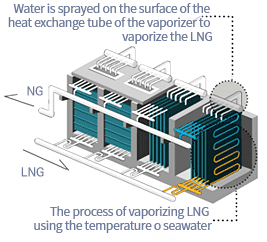
Vaporizers are categorized into three types: seawater vaporizers, which use sensible heat from seawater to vaporize LNG; combustion vaporizers, which use heat generated by burning natural gas; and air vaporizers, which use atmospheric air as a heat exchange medium.
Seawater vaporizers transfer sensible heat of seawater to LNG, and vaporize it by spraying seawater from the top to the bottom while LNG transported from the high-pressure pump passes from the bottom to the top of the heat exchanger, which is made in the form of a thin plate. When natural gas demand exceeds the capacity of the seawater vaporizer, or when the production capacity of the seawater vaporizer decreases due to the low seawater temperature in winter, a combustion type carburetor is used.Combustion Type Vaporizer
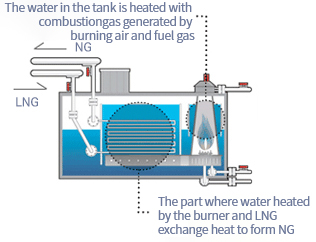
Combustion type vaporizers vaporize LNG by heating water with heat generated by burning air and natural gas in a submerged tank of water. After passing through the vaporizer, Natural gas in gaseous state (NG) is supplied to consumers through a nationwide pipeline network after being metered and having an odorant injected to aid detection of gas leaks by smell.
Air Vaporizer
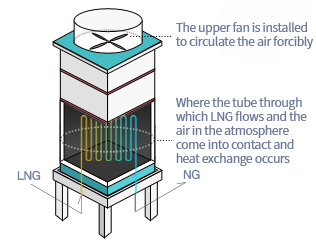
Air vaporizers vaporize LNG through heat exchangers when the tube through which LNG flows comes into contact with air. Air vaporizers are an eco-friendly devices that use atmospheric air as a heat source, and these operate at the Jeju LNG terminal.


